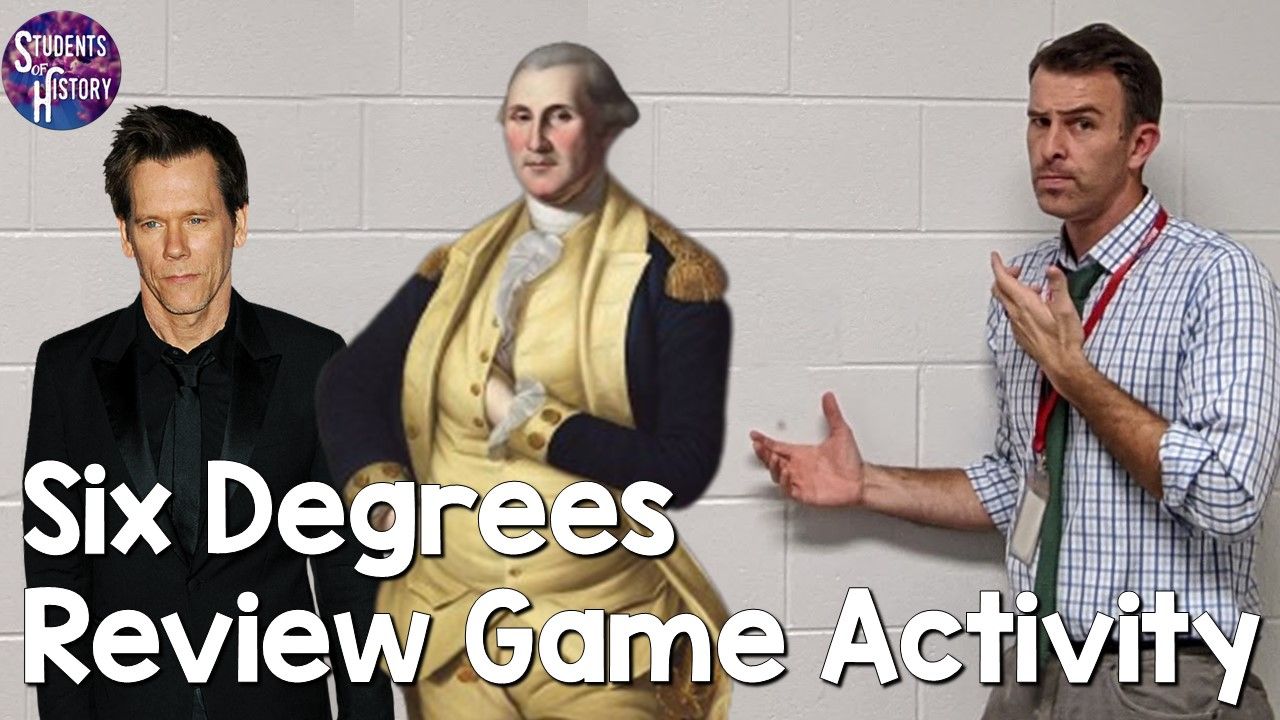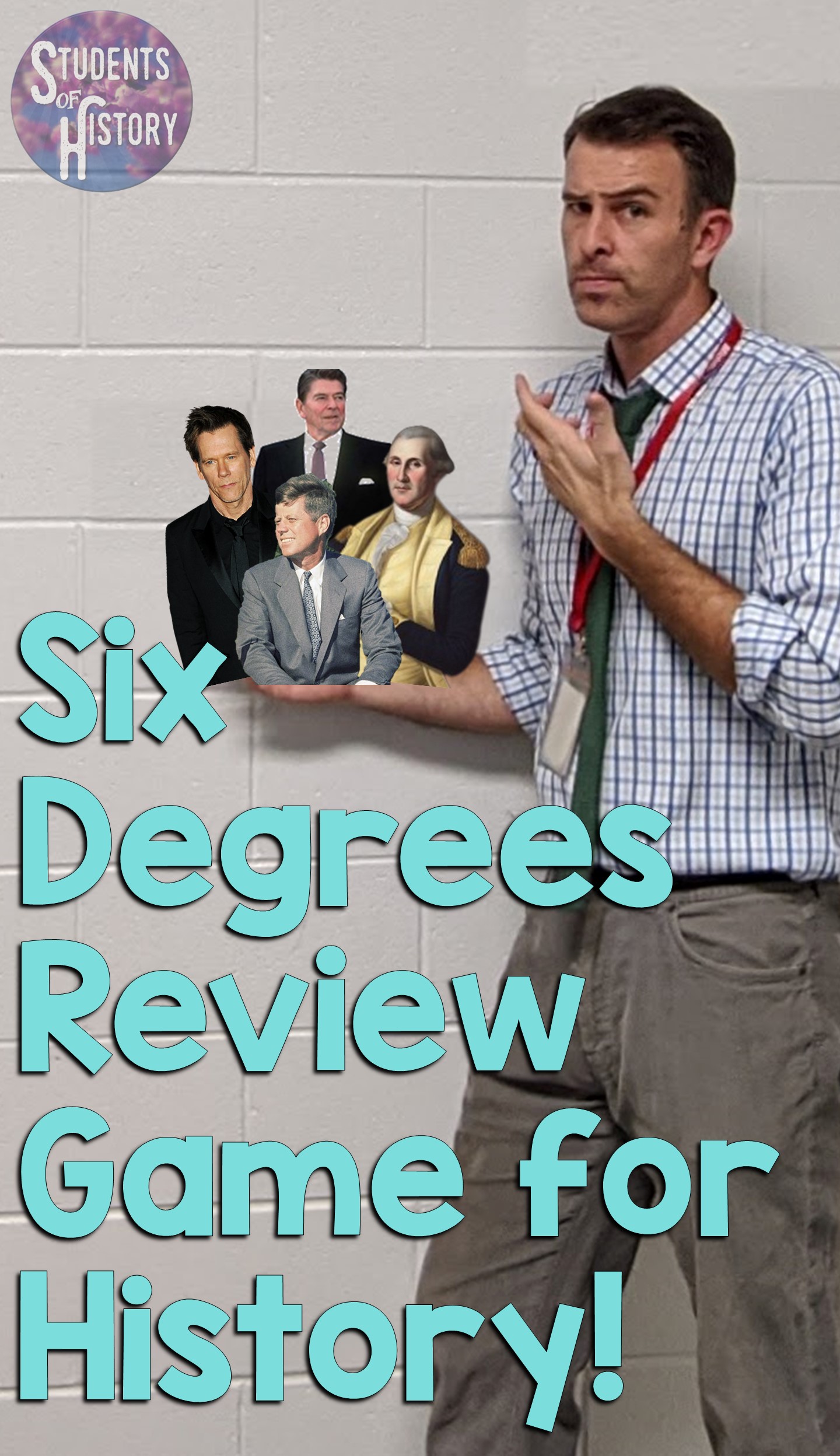6 Degrees of Separation Game for History

History is a tapestry of interconnected events, people, and ideas. Helping students to make connections in your curriculum is a powerful way to deepen their understanding of history and to see its connection to the world today.
An awesome way to promote this understanding is through a fun and interactive classroom game called "Six Degrees of Separation."
It's inspired by the old parlor game "Six Degrees of Kevin Bacon" that you might have played in college. In that version, someone picks a random actor and you have to connect them through films and other actors who have appeared together until you reach Kevin Bacon.
For example, if you were given the actress Zendaya:
Zendaya was in Dune with Josh Brolin. He was in was in Hollow Man with Kevin Bacon.
It's fun to allow students to try some out with actors they might know. A website called the Oracle of Bacon is helpful for finding examples.
There's a couple different ways you can use this game in the classroom.
First, you could do it just like the Six Degrees of Kevin Bacon game and have students make connections with people from your curriculum.
For example, if you could have Franklin D. Roosevelt take the role of Bacon and provide students a list of people they had to connect to him.
For example:
Martin Luther King, Jr gave his "I Have a Dream" speech at the Lincoln Memorial, where Marian Anderson performed in 1939 at the suggestion of Eleanor Roosevelt, wife of FDR.
Thomas Jefferson founded the University of Virginia, where Robert F. Kennedy studied law, who was John F. Kennedy's brother, who selected Eleanor Roosevelt to lead a Presidential Commission on the Status of Women, who was FDR's wife.
As you can imagine, are sometimes challenging, but fun for advanced or AP level history students. They encourage critical thinking, creativity, and research skills. They also enhance your students' ability to perceive the intricate web of human history.
If you want to try the game with middle school or on-level students, there are accommodations you can make to make it fun for them.
Here's how to do that:
Step 1: Choose the Vocabulary Terms:
Select six vocab terms from the unit or time period you are covering. Ensure that the terms have some potential connections with each other. For example, if you are studying the Early Republic in US History, your 6 terms could be: Federalists, XYZ Affair, Lewis & Clark, Tecumseh, Louisiana Purchase, and Monroe Doctrine.
I like a mix of vocabulary terms and people for students to connect
Step 2: Introduce the Activity:
Explain the concept of "Six Degrees of Separation" to your students. Emphasize that they will need to find connections between the terms by identifying people, events, or ideas that link them together.
Encourage your students to be creative and think critically. I tell students that I award "bonus points" to the most creative connections and ones I never saw coming.
Step 3: Research
Allow students to work together (I like pairs or groups of 3 for this activity) and give them time to research and explore the vocabulary terms. I have them use my online textbook and other online sources plus their notebooks and textbook. Any sources available I encourage them to use.
Step 4: Map the Connections
After conducting their research, students should organize their findings into a visual representation. They can create a concept map or a flowchart to illustrate the connections between the terms.
This visual representation will help other students understand the connections and allow students to demonstrate their understanding of the relationships.
Step 5: Present and Discuss
Provide an opportunity for students to present their findings to the class. Encourage them to explain the connections they discovered, highlighting the historical significance of each link.
As a class, discuss the creative connections that students identified. This discussion will foster a deeper understanding of your content and help all students to make more creative connections the next time you do the activity.
Step 6: Reflection and Extension:
Conclude the activity with a reflection session. Ask your students to complete an exit ticket on the activity, the connections they found most interesting, and the challenges they encountered.
Additionally, you can extend the activity by challenging students to create their own sets of vocabulary terms and connections, thereby promoting further exploration and creativity.
Conclusion
What do you think? Is this an activity you might try in your classroom?
If so, I would love to hear how it goes! Please tag me or reach out on social media. I am @studentsofhistory on Instagram.
I hope this activity helps to empower your students to uncover the hidden connections that shape our world!

Want to try some lessons for free?
Try out some free lesson plans and resources for your social studies classroom!
Don't worry, your information is never shared.